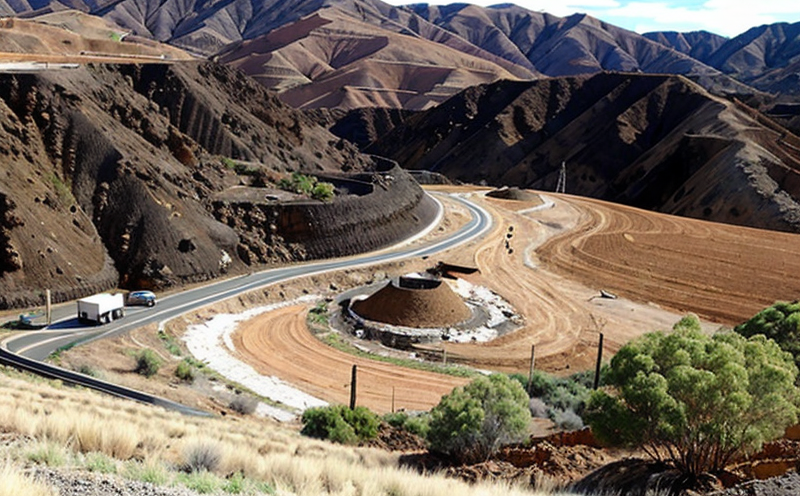ISO 11074 Classification of Soils in Restored Mine Areas
The ISO 11074 standard provides a systematic approach to the classification and characterization of soils found in restored mine areas. This process is critical for ensuring that rehabilitation efforts meet environmental, safety, and regulatory requirements. The primary goal of this service is to determine whether the soil in a rehabilitated area meets the necessary criteria for stability, erosion resistance, and overall suitability for reclamation.
The classification process involves several key steps, all of which are designed to provide comprehensive information on the physical properties and potential risks associated with the soils. The first step is the site assessment, where we identify the type of mine area being rehabilitated—whether it's a surface or underground mine—and gather data on the original soil characteristics before mining began.
The next phase involves sample collection and preparation. This process ensures that the samples accurately represent the conditions in the field. Samples are collected from various depths and locations, ensuring a thorough representation of the site's soil composition. Once collected, these samples undergo rigorous laboratory testing to determine their physical properties.
The analysis covers several critical parameters including particle size distribution, plasticity index, liquid limit, and more. These tests help us understand how the soil behaves under different conditions, which is essential for predicting its long-term performance after rehabilitation. Additionally, we perform structural integrity assessments, using advanced geotechnical techniques to evaluate the stability of the soil layers.
The results of these analyses are then used to classify the soils according to ISO 11074 standards. This classification helps in determining if the soil is suitable for supporting structures like roads, buildings, or other infrastructure that may be installed during and after reclamation. The classification also informs decisions about any further treatment required to enhance stability or reduce risks.
Once classified, we provide detailed reports outlining our findings. These reports include recommendations on how best to manage the soil in its current state and future conditions. This information is invaluable for quality managers, compliance officers, R&D engineers, and procurement teams who need assurance that the reclamation efforts are both effective and compliant with relevant standards.
Our approach ensures not only regulatory compliance but also aligns with broader sustainability goals by promoting responsible mining practices. By accurately classifying these soils, we contribute to creating safer, more resilient environments post-mining operations.
Benefits
- Ensures regulatory compliance and environmental protection.
- Promotes sustainable mining practices.
- Reduces risk of soil erosion and landslides in rehabilitated areas.
- Aids in the development of safe infrastructure for post-mining use.
- Provides detailed insights into the physical properties of soils.
- Supports long-term planning for land reclamation projects.
The benefits extend beyond mere compliance; they also contribute to the overall health and safety of both workers and ecosystems around mining sites. By accurately classifying soils, we ensure that the rehabilitation process is thorough and effective, leading to more sustainable outcomes in post-mining landscapes.
Industry Applications
- Sustainable Mining Practices: Ensures compliance with ISO standards while promoting responsible mining practices.
- Erosion Control: Helps in preventing soil erosion and landslides, which are common issues in rehabilitated mine areas.
- Infrastructure Development: Supports the planning and development of safe infrastructure such as roads, buildings, and other facilities within reclaimed spaces.
- Safety Management: Provides detailed data that supports safer working conditions for personnel involved in reclamation projects.
The ISO 11074 classification is particularly valuable in industries where environmental impact assessment (EIA) is a crucial component of operations. It allows companies to demonstrate their commitment to sustainable development and responsible resource management, enhancing their reputation among stakeholders and the public.
Eurolab Advantages
At Eurolab, we bring decades of experience in environmental testing and quality assurance to our ISO 11074 classification services. Our team of experts ensures that every step of the process—from sample collection to final reporting—is conducted with precision and accuracy.
- Expertise: Leveraging years of industry knowledge, we provide tailored solutions for each unique mine site.
- State-of-the-Art Facilities: Utilizing cutting-edge laboratory equipment allows us to perform precise soil analysis.
- Detailed Reporting: Comprehensive reports that go beyond simple classifications, offering actionable insights into the future management of the site.
- Compliance Assurance: Ensuring all tests meet the stringent requirements set by ISO 11074 and other relevant international standards.
We pride ourselves on delivering reliable results that help our clients make informed decisions about their reclamation projects. Our commitment to excellence ensures that every project meets not only regulatory but also practical needs, contributing significantly to successful land restoration efforts.





